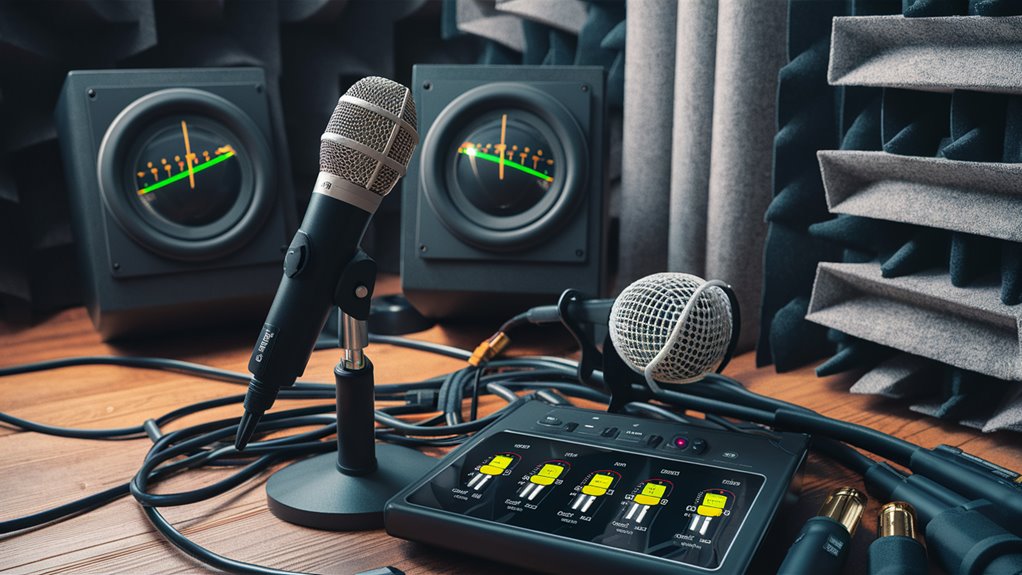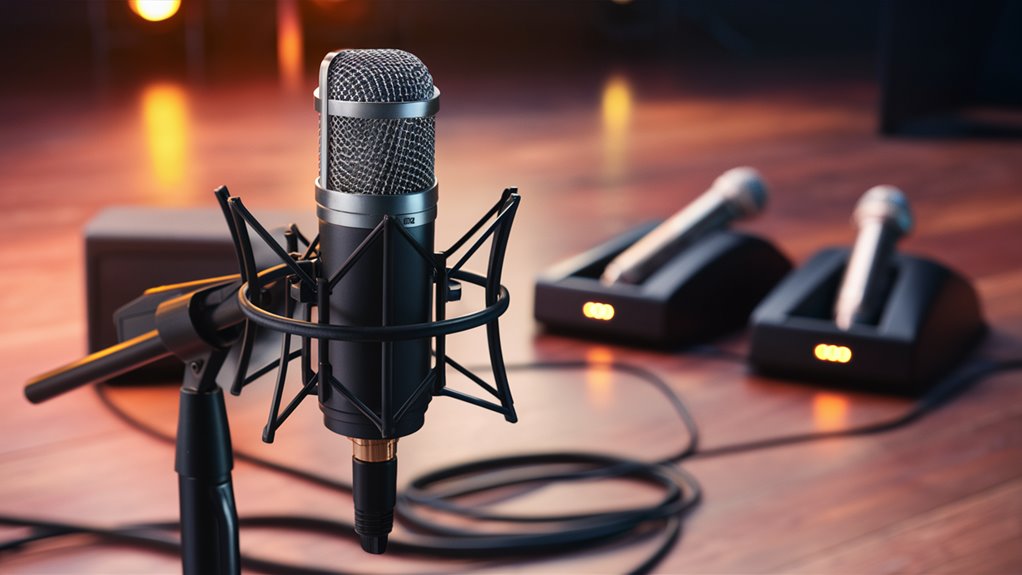All You Need to Know: Karaoke Sound Gear: Mics and Speakers

Picking the Right Mic
Dynamic cardioid mics are top picks for karaoke, known for their great feedback blocking and tough build for live singing. These mics cut out background noise by 15-20dB, making sure your voice is clear and free from any unwanted sound.
What Speakers to Use
To get that clear karaoke sound, use bi-amped speakers with at least 150W RMS power. Key parts include:
- 12-15″ woofers for deep low sounds
- Can handle 40Hz-2kHz sounds
- Spread sound 90° side to side
- High-power drivers for loud, clear sound
Where to Put Your Gear
Set up your sound gear smartly:
- Put speakers at the height of your ears
- Turn speakers 45° out for good sound spread
- Keep mics three feet from speakers
- Place monitors to avoid sound loops
Make Your Sound Better
Boost your setup by:
- Adjusting EQ for clear voice
- Fixing up room sound for better audio
- Stop feedback with right gain levels
- Place monitors right for singer confidence
Check and tweak your system often, change settings as the room feel shifts to keep sound top-notch.
Know Your Mic Types
All About Karaoke Mic Types
Needed Mic Kinds for Karaoke
The right karaoke mic can make or break how you sound. Let’s look at the three main mic types used in karaoke gear.
Dynamic Mics for Karaoke
Dynamic mics are often chosen for pro karaoke setups because they are tough and block feedback well. They work great in loud spots and are very strong against noise from handling. They’re built tough to handle loud sounds, making them perfect for busy karaoke places.
Condenser Mics for Top Sound
Condenser mics give top voice clarity and grab tiny sound details well. These need extra power and careful handling, best for quiet clean spots. They pick up sound so well, they’re ideal for serious singers and recording.
Wireless Mic Tech
Wireless mic systems free you to move but need careful tech handling. New tech with digital send in 2.4GHz or 5.8GHz avoids usual signal mess. Dual-antenna systems keep connection steady and clear, cutting out drops during key performances.
Points to Watch
- Sound range for voice
- Feedback blocking
- Noise to sound rate for clear sound
- Battery life in wireless gear
- Build quality and strength
- Plugging with various karaoke tools
Needed Speaker Traits
Key Speaker Traits for Karaoke Gear
Must-Have Sound Traits
Sound range is key in karaoke sound. Speakers should cover from deep 20Hz to sharp 20kHz, catching all notes from deep bass to high clear sounds. Power needs tell how steady performance is – small spots need at least 150 watts RMS, bigger spots need 300+ watts to keep sound clear at high volumes.
Top-Level Driver Setup
Best karaoke speakers need special drivers:
- At least 12-inch woofer for strong deep sounds
- Mid-range driver for great voice clarity
- High-range tweeter for clear high tones
Bi-amp and tri-amp setups split sound for precise control, a must for pro karaoke use.
Karaoke Sound Boosts
Set voice clear in the 2kHz-4kHz range for clear singing. Top karaoke speakers have:
- Built-in feedback cut
- Adjustable EQ
- 90-degree sound spread left/right
- 60-degree sound throw top/bottom
These make sure sound is even in the show space, giving everyone a great karaoke time, whether singing or listening.
Room Size and Sound
Room Size and Sound for Best Karaoke

Know Your Room and Sound
Room sound is huge in making a perfect karaoke spot. The big three sound elements are room size, surface type, and around sound level. For home karaoke, use 20-30 watts RMS for every 100 square feet to hit good sound levels.
Handle Sound Bounce and Wall Fixes
Hard bounce surfaces like stone and glass can mess with voice clarity by bouncing sound back. Placing sound panels is key, especially on walls to the sides and back. Small spots under 200 square feet do best with 2-4 inch thick panels covering 15-20% of the wall.
Big Room Sound and Speaker Spots
For rooms over 500 square feet, focus on managing room modes and standing waves with smart speaker spots. Place main speakers 38% of room length from the front wall, with subwoofer spots set for best sound. Start crossovers at 80Hz, tweaking based on full room sound tests for best audio results 호치민 가라오케
Sound System Tips
Pro Sound System Setup Tips
Speaker Spots and Setup
Right speaker spots are key for top sound quality. Place main speakers at your ear level, turned 45 degrees from where the show is. Put your subwoofer in a corner to boost low sound while keeping it clear. This setup balances sound all over the space.
Mixer and EQ Tips
Start with middle EQ settings on your mixer. Set the main sound gain to 75% to keep room for volume changes. Use a high-pass filter at 100Hz on voice mics to cut low noise and drop feedback risk.
Signals and Cables
Use balanced XLR cables for all mic links to keep the signal clean. Good grounding cuts out unwanted buzz and mess. Match your amp’s input needs to your mixer’s output for best gain setup. Use a real-time analyzer to spot and fix feedback sounds with exact EQ changes. Set monitor levels to give singers clear voice feedback while keeping a good mix for the crowd.
Boost Your System
- Set crossover points between speakers and subwoofers
- Tune system EQ with pink noise and test mics
- Time-align speakers for sound phase match
- Use compression on voice channels to manage sound ups/downs
- Set right gain levels all through your sound chain
- Singing on Your Phone
These steps keep your sound pro and your system running smooth.
Handling Sound Feedback
Pro Ways to Manage Sound Feedback in Karaoke Gear
Key Feedback Stops
Managing sound feedback is key in pro karaoke setups. Good control stops loud squeals and keeps gear and show quality safe. This in-depth guide gives you the best ways to manage sound.
Smart Speaker Spots
Where you put speakers matters a lot in stopping feedback:
- Place speakers ahead of where the mic picks up sound
- Keep gear at least 3 meters apart
- Turn speakers 30-45 degrees to stop sound bounce
- Make sound spread just right
Tech for Better Sound
Handling Frequencies
- Focus on key sound ranges (250Hz-2kHz)
- Make exact EQ tweaks
